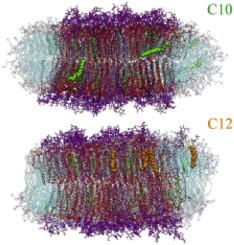Journal of Molecular Graphics and Modelling ( IF 2.7 ) Pub Date : 2020-09-02 , DOI: 10.1016/j.jmgm.2020.107732 Patricio A Zapata-Morin 1 , F J Sierra-Valdez 2 , J C Ruiz-Suárez 3

|
n-Aliphatic alcohols act as anesthetics only up to a certain chain length, beyond which its biological activity disappears. This is known as the ‘cut-off’ phenomenon. Although the most accepted explanation is based on action sites in membrane proteins, it is not well understood why alcohols alter their functions. The structural dependence of these protein receptors to lipid domains known as ‘lipid rafts’, suggests a new approach to tackle the puzzling phenomenon. In this work, by performing molecular dynamic simulations (MDS) to explore the lipid role, we provide relevant molecular details about the membrane-alcohol interaction at the cut-off point regime. Since the high variability of the cut-off points found on protein receptors in neurons may be a consequence of differences in the lipid composition surrounding such proteins, our results could have a clear-cut importance.
中文翻译:

n-醇在脂筏中的截止作用:一种脂依赖现象☆。
正脂肪醇仅在一定的链长范围内才用作麻醉剂,超过一定的链段其生物学活性就会消失。这被称为“截止”现象。尽管最公认的解释是基于膜蛋白中的作用位点,但对于为什么醇会改变其功能尚不十分了解。这些蛋白质受体对称为“脂质筏”的脂质结构域的结构依赖性,提出了一种解决令人费解的现象的新方法。在这项工作中,通过执行分子动力学模拟(MDS)来探索脂质的作用,我们提供了在截止点状态下膜-醇相互作用的相关分子详细信息。由于神经元中蛋白质受体上的截止点的高变异性可能是这些蛋白质周围脂质组成差异的结果,











































 京公网安备 11010802027423号
京公网安备 11010802027423号